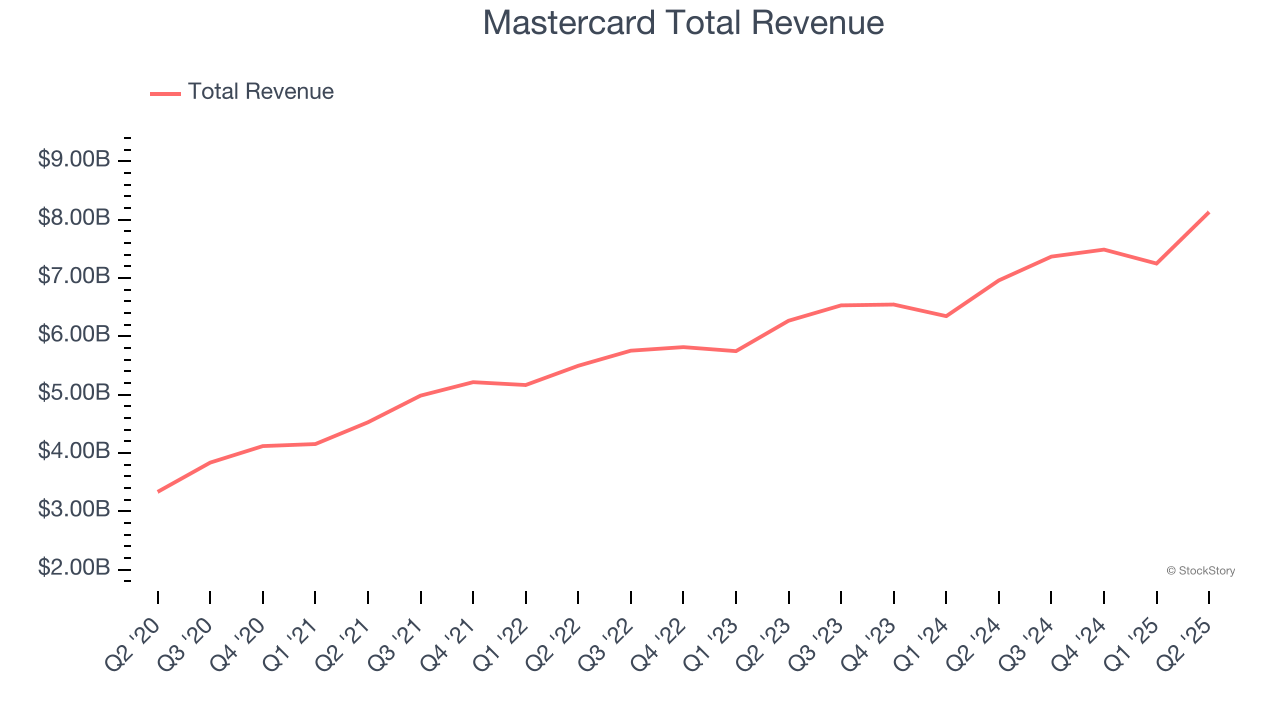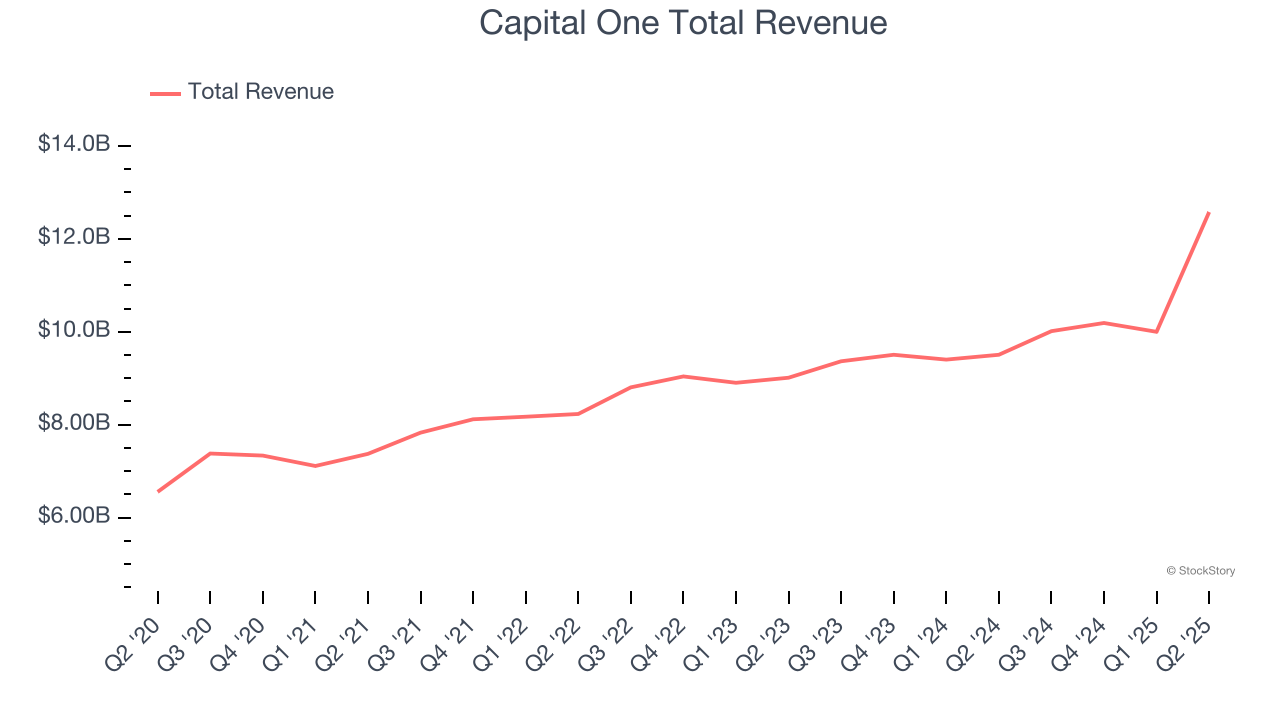
Wrapping up Q2 earnings, we look at the numbers and key takeaways for the credit card stocks, including Mastercard (NYSE: MA) and its peers.
Credit card companies facilitate electronic payments and extend revolving credit to consumers. Growth comes from increasing digital payment adoption, cross-border transaction growth, and value-added services for cardholders and merchants. Challenges include regulatory scrutiny of fees and practices, competition from alternative payment methods, and potential credit losses during economic downturns.
The 6 credit card stocks we track reported a strong Q2. As a group, revenues beat analysts’ consensus estimates by 0.5%.
In light of this news, share prices of the companies have held steady as they are up 1.1% on average since the latest earnings results.
Mastercard (NYSE: MA)
Recognizable by its iconic "Priceless" advertising campaign that has run in over 120 countries, Mastercard (NYSE: MA) operates a global payments network that connects consumers, financial institutions, merchants, and businesses, enabling electronic transactions and providing payment solutions.
Mastercard reported revenues of $8.13 billion, up 16.8% year on year. This print exceeded analysts’ expectations by 2.1%. Overall, it was a strong quarter for the company with a decent beat of analysts’ EBITDA and EPS estimates.

Interestingly, the stock is up 1.1% since reporting and currently trades at $566.60.
Read why we think that Mastercard is one of the best credit card stocks, our full report is free.
Best Q2: Capital One (NYSE: COF)
Starting as a credit card company in 1988 before expanding into a full-service bank, Capital One (NYSE: COF) is a financial services company that offers credit cards, auto loans, banking services, and commercial lending to consumers and businesses.
Capital One reported revenues of $12.58 billion, up 32.3% year on year, falling short of analysts’ expectations by 0.6%. However, the business still had a very strong quarter with a beat of analysts’ EPS estimates and an impressive beat of analysts’ net interest margin estimates.

Capital One achieved the fastest revenue growth among its peers. The market seems content with the results as the stock is up 2.4% since reporting. It currently trades at $222.44.
Is now the time to buy Capital One? Access our full analysis of the earnings results here, it’s free.
Weakest Q2: American Express (NYSE: AXP)
Recognizable by its iconic green logo and the slogan "Don't leave home without it," American Express (NYSE: AXP) is a global payments company that issues credit and charge cards, processes merchant transactions, and offers travel and lifestyle benefits to consumers and businesses.
American Express reported revenues of $13.24 billion, up 9.4% year on year, in line with analysts’ expectations. Still, it was a satisfactory quarter as it posted a narrow beat of analysts’ transaction volumes estimates.
Interestingly, the stock is up 7.7% since the results and currently trades at $339.98.
Read our full analysis of American Express’s results here.
Bread Financial (NYSE: BFH)
Formerly known as Alliance Data Systems until its 2022 rebranding, Bread Financial (NYSE: BFH) provides credit cards, installment loans, and savings products to consumers while powering branded payment solutions for retailers and merchants.
Bread Financial reported revenues of $929 million, down 1.1% year on year. This print came in 0.6% below analysts' expectations. More broadly, it was actually a very strong quarter as it recorded a beat of analysts’ EPS estimates.
The stock is down 6.4% since reporting and currently trades at $60.06.
Read our full, actionable report on Bread Financial here, it’s free.
Synchrony Financial (NYSE: SYF)
Powering over 73 million active accounts and partnerships with major brands like Amazon, PayPal, and Lowe's, Synchrony Financial (NYSE: SYF) provides credit cards, installment loans, and banking products through partnerships with retailers, healthcare providers, and digital platforms.
Synchrony Financial reported revenues of $3.65 billion, down 1.8% year on year. This result missed analysts’ expectations by 1.3%. Aside from that, it was a strong quarter as it logged a beat of analysts’ EPS estimates and a solid beat of analysts’ net interest margin estimates.
Synchrony Financial had the weakest performance against analyst estimates and slowest revenue growth among its peers. The stock is up 6.9% since reporting and currently trades at $74.27.
Read our full, actionable report on Synchrony Financial here, it’s free.
Market Update
In response to the Fed’s rate hikes in 2022 and 2023, inflation has been gradually trending down from its post-pandemic peak, trending closer to the Fed’s 2% target. Despite higher borrowing costs, the economy has avoided flashing recessionary signals. This is the much-desired soft landing that many investors hoped for. The recent rate cuts (0.5% in September and 0.25% in November 2024) have bolstered the stock market, making 2024 a strong year for equities. Donald Trump’s presidential win in November sparked additional market gains, sending indices to record highs in the days following his victory. However, debates continue over possible tariffs and corporate tax adjustments, raising questions about economic stability in 2025.
Want to invest in winners with rock-solid fundamentals? Check out our Strong Momentum Stocks and add them to your watchlist. These companies are poised for growth regardless of the political or macroeconomic climate.
StockStory is growing and hiring equity analyst and marketing roles. Are you a 0 to 1 builder passionate about the markets and AI? See the open roles here.





